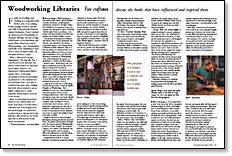Woodworking Libraries
Five craftsmen discuss the books that have influenced and inspired them
Synopsis: Many woodworkers have been drawn to the craft because of a book. And many a woodworker’s education has come largely from the printed page. So Vincent Laurence of Fine Woodworking asked five woodworkers to discuss the books that have affected them, the books they rely on still, and the books they’d recommend. Laurence adds his own inspiration list. The experts who share their reading lists include Harriet Hodges, Mario Rodriguez, Christian Becksvoort, Ernie Conover, and Alphonse Mattia.
Fresh out of college and working as a carpenter in the Boston area, I was making barely enough money to pay the rent. Still, I’d frequent the Harvard Square bookstores. There, I picked up Ernest Joyce’s Encyclopedia of Furniture Making, the first of Tage Frid’s books on woodworking and many others. After four years of Phenomenology and Existentialism and its ilk, it was refreshing to read how to fold a bandsaw blade, cut dovetails and tune a plane.
When I discovered George Nakashima’s The Soul of a Tree, I was floored by his sketches, the photos of the lumber he used and those tables. Krenov’s The Impractical Cabinetmaker had a similar effect. It resonated powerfully because he articulated my attraction to the material and process better than I was able to myself at that point. After reading that book, there seemed to me no higher calling than to make beautiful, useful objects of wood. I was moved.
Many woodworkers have been drawn to the craft because of a book. And many a woodworker’s education has come largely from the printed page. So I asked five woodworkers to discuss the books that have affected them, the books they rely on still and the books they’d recommend. Harriet Hodges: While learning to turn and to make chairs, I always looked to books as teachers, preferring their unobtrusive instruction. Though I realize how helpful it is for someone to say, “No, not that way” and grab my skew, I find that with the right books in my library, I can accept correction humbly at the lathe and sneak to see if Richard Raffan concurs.
One always needs passions bolstered and refined. Mine for the handmade, the old way, were upheld by Eric Sloane. I scorned the electric cord. Sloane’s book, A Museum of Early American Tools, is a fine introduction to old hand tools. In it, I learned the difference between a scorp and a spokeshave. If you can, also buy Salaman’s Dictionary of Woodworking Tools, which illustrates all manner of spokeshaves, witchets and floor planes.
Richard Starr’s Woodworking with Your Kids is an ideal first book for the person drawn to hand tools but without antiquarian obsession. The photos are of children demonstrating various techniques and proudly displaying the fruits of their efforts. A powerful message here, “If that 12-year-old can make that guitar with nothing but those tools, so can I.”
A step up from Starr into a wider range of tools and processes is Herman Hjorth’s Principles of Woodworking, first published in 1930. It’s a shop handbook with many pictures of boys in ties working industriously. I have seen many introductory texts, but none beats Hjorth’s for orderly and clear presentation on the complete range of subjects a novice woodworker needs to know, such as hand tools, sharpening, use and care of machines, and finishes. James Krenov’s books are inspiring and can be helpful if one wants to explore the subtleties hand tools make possible.
From Fine Woodworking #121
For the full article, download the PDF below:
Fine Woodworking Recommended Products

Dividers

Drafting Tools

Sketchup Class






















Log in or create an account to post a comment.
Sign up Log in